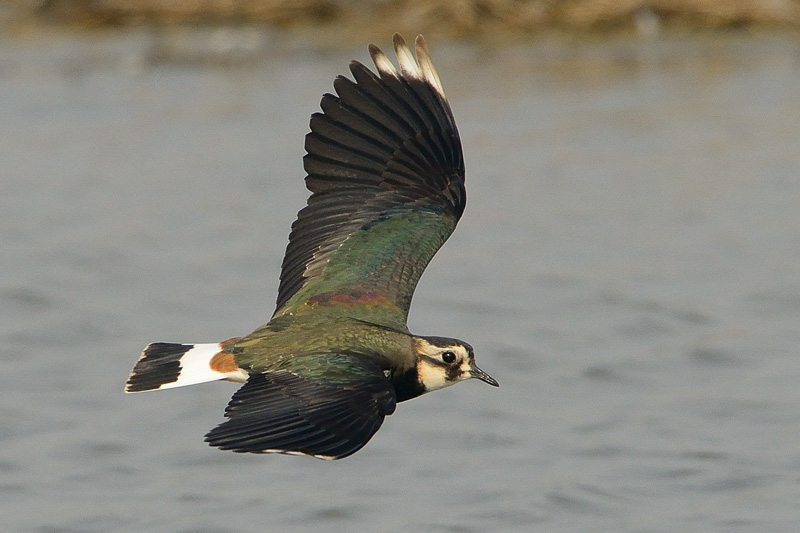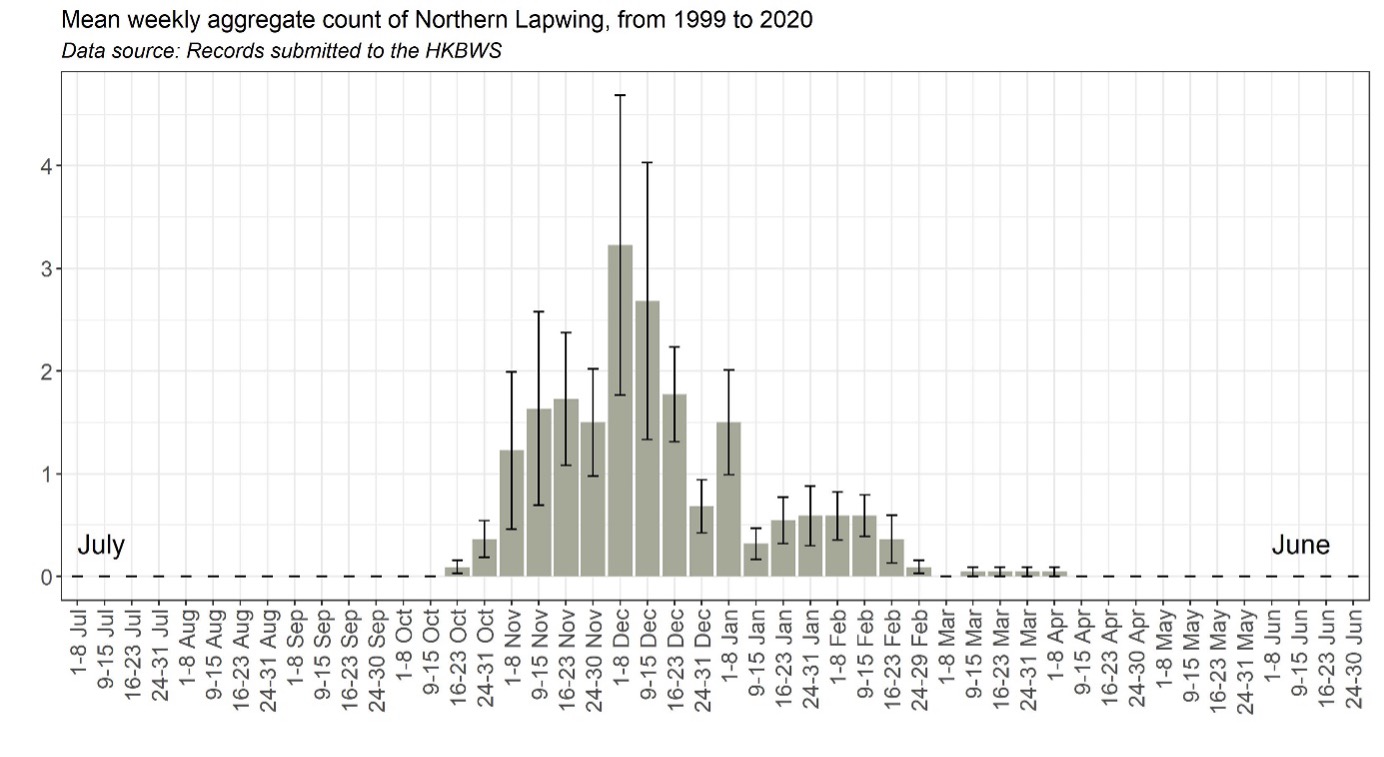Northern Lapwing Vanellus vanellus 鳳頭麥雞
Category I. Scarce winter visitor to open-country habitats, numbers possibly declining.
IDENTIFICATION

Oct. 2022, Paul Leader. First-winter.
28-31 cm. Medium-sized plover with dark crown, long thin crest, black and white face pattern, greenish-tinged dark upperparts, orange-buff undertail coverts and pink legs. First-winter birds such as this have pale buff tips to the upperpart feathers.

Nov. 2017, Kinni Ho. First-winter.
Broad and rounded white-tipped dark wings, dark-tipped white tail and white underparts are distinctive in flight. The very broad outer half of the wing indicates this is a male; on females this is narrower.
VOCALISATIONS
Very distinctive voice and quite a vocal species. Calls sound somewhat plaintive or even desperate and slightly nasal.
DISTRIBUTION & HABITAT PREFERENCE
Most records are from the flat and low-lying areas of the northwest New Territories, particularly Mai Po NR, but also nearby areas such as the commercial fish ponds, Long Valley and Kam Tin. Away from this area, up to five birds have been recorded at the former and present airports of Kai Tak and Chek Lap Kok respectively, on the Castle Peak coast, at Ho Chung, Tai Long Wan, Tai Po (including Ting Kok and Shuen Wan) and Pui O.
The lack of its preferred wintering habitat of grassland and rough farmland in both HK and Guangdong is thought to account for the erratic nature of its occurrence here, although the relatively low number of records at the former and current airports suggests that the species is probably rather scarce in this part of China.
OCCURRENCE
Northern Lapwing is a scarce winter visitor of erratic occurrence, with no records at all in some winter periods. The highest numbers are associated with the passage of cold fronts from the north.
The earliest autumn record is of one at Mai Po on the remarkable date of 6 September 1987; the next earliest occurred on 13 October 1974. The main period of occurrence since 1999 is from the first week of November to the middle of February, with numbers generally peaking in the first half of December (Figure 1). The highest counts are 126 on 21 November 1992 and 109 on 29 December 1991, both related to significant surges of the northeast monsoon that brought cold weather to the region; the next highest is 40 on 6 February 1976.
Until 1989 there was no record after the middle of February, but that year saw the beginning of the occasional occurrence of one to three migrants during the early spring period up to 2003, usually no later than the first week of April. One recorded on 13 May 1994 is the latest on record. Since 2003, however, there has been no record later than the end of February.
The period from the mid-1980s to the mid-1990s saw relatively high numbers of Northern Lapwing recorded, while peak counts before were slightly higher than those since, on average. However, observer effort this century is much higher than the period up to the mid-1980s, and so it is likely that there has been a decrease in numbers occurring.
Vaughan and Jones (1913) referred to Northern Lapwing as a winter visitor to Guangzhou and further west. Herklots (1953) recorded two flocks of twelve and three, the first on 8 December 1934 being the first record in HK.
BEHAVIOUR, FORAGING & DIET
Prey is located aurally or visually, birds walking or running for a short distance and stopping to listen or probe. Larger flocks appear to occur as a cold weather response, and generally speaking do not remain for long.
RANGE & SYSTEMATICS
Monotypic. Breeds from western Europe east through Scandinavia and eastern Europe across Russia and Kazakhstan to Mongolia and northeast China; winters close to the breeding grounds in western Europe while other populations move south to wintering areas in southern Europe, north African coastal areas, Iran, northwest India, south China, South Korea and southern Japan (Wiersma et al. 2020). In China breeds in Xinjiang and the northeast, and winters along the Yangtze floodplain south to the coast, including Taiwan and Hainan (Liu and Chen 2020).
CONSERVATION STATUS
IUCN: Near-threatened. Population trend decreasing, suspected to be at a moderately rapid rate.
Figure 1.

Herklots, G. A. C. (1953). Hong Kong Birds. South China Morning Post, Hong Kong.
Liu, Y. and Y. H. Chen (eds) (2020). The CNG Field Guide to the Birds of China (in Chinese). Hunan Science and Technology Publication House, Changsha.
Vaughan, R. E. and K. H. Jones (1913). The birds of Hong Kong, Macao and the West River or Si Kiang in South-East China, with special reference to their nidification and seasonal movements. Ibis 1913: 17-76, 163-201, 351-384.
Wiersma, P., G. M. Kirwan, and C. J. Sharpe (2020). Northern Lapwing (Vanellus vanellus), version 1.0. In Birds of the World (J. del Hoyo, A. Elliott, J. Sargatal, D. A. Christie, and E. de Juana, Editors). Cornell Lab of Ornithology, Ithaca, NY, USA. https://doi.org/10.2173/bow.norlap.01

